- Home
- Encyclopedia
- Laramie County, Wyoming
Laramie County, Wyoming
Laramie County’s history is tied to a geography that made Cheyenne a crossroads for commerce and transportation. Both the city and the county lie at the intersection of a north-south route along the east front of the Rocky Mountains steadily in use for hundreds if not thousands of years, and an east-west route pioneered in the mid-1800s by railroad promoters looking for an easier way from the Great Plains over the mountains and into the basins of the interior West.
Fort D. A. Russell
That story begins in the 1860s with a survey of the area by representatives of the Union Pacific Railroad Co. At the time, the main populations of white people in that region of Dakota Territory were at Fort Laramie and Fort Bridger, and totaled fewer than 1,000 persons.
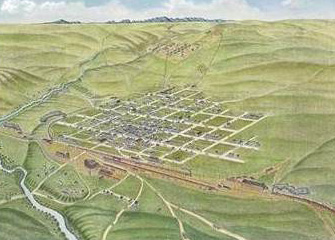
On a military expedition in 1865, U.S. Army Gen. Grenville Dodge discovered the “gangplank”—an even-graded, topographical ramp in the Laramie Range west of present Cheyenne that reaches an elevation of 8,465 feet. Two years later, on June 28, 1867, Dodge, on leave from the U.S. Army and soon to be chief engineer for Union Pacific, visited the area with Gen. John A. Rawlins, chief of staff from the U.S. Army and Army Gen. C. C. Augur.
Dodge determined the route up the gangplank and across the plains to Fort Bridger was 40 miles shorter than the Oregon Trail, which followed the North Platte and Sweetwater rivers further north. The new route was also attractive as it ran past coal deposits easily mined for fuel for the UP locomotives. In addition, nearby Crow Creek was a good water source.
Augur designated a spot along the north bank of the creek as the site for a fort to protect railroad workers. On Sept. 8, 1867, the fort was named Fort David A. Russell, for a Union brigadier general killed in a Civil War battle at Opequon, Va., in 1864.
At Fort Russell, the Army established the Camp Carlin freight depot, which became the second-largest military supply depot in the United States and the largest west of the Mississippi. Workers began receiving, storing and distributing supplies on Dec. 10, 1867, about a month after the UP tracks had arrived at the town of Cheyenne, then a few months old.
Camp Carlin distributed supplies by freight wagon to 12 army posts and Indian agencies. The camp had 16 large warehouses, blacksmith shops, carpenter shops, saddle and harness shops, wagon sheds and stables, cook houses, bunk houses and military quarters. The Army kept 1,000 mules at Camp Carlin, and 100 freight wagons and five pack trains were assigned to operate from there.
In 1890 a Union Pacific subsidiary, the Chicago and Northern Railroad, laid track from Cheyenne north to Fort Laramie. With the extended rail service, there was less need to take freight off the end of the line in Cheyenne and haul by mule train from there, and Camp Carlin closed.
Troops trained for the Spanish American War and for World War I at Fort Russell. At that time, early in the 20th century, it was one of the largest military posts in the United States. The fort was renamed in 1930 in honor of Frances E. Warren, first governor of the state and Wyoming’s U.S. senator from 1890 to 1929. Beginning after World War II in 1947, the new U.S. Air Force, descendant of the Army Air Corps, used the installation for training, and it was renamed Francis E. Warren Air Force Base.
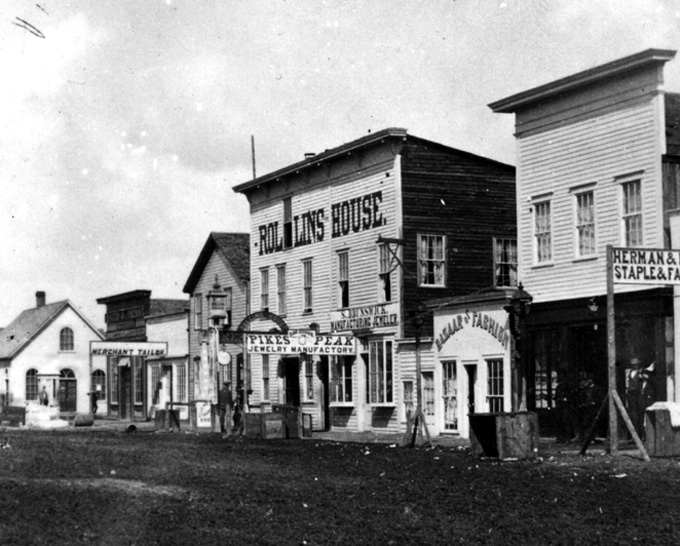
In 1958, the Strategic Air Command took command of Warren, which became an Intercontinental Ballistic Missile headquarters, and the base that once hosted band concerts and baseball games for the community of Cheyenne greatly restricted public access. Warren Air Force Base is considered essential to the financial well being of Laramie County. In 2011 it contributed $364 million to the local economy.
Laramie County government
The first entity called Laramie County, meanwhile, was created by the legislature of the Dakota Territory on Jan. 8, 1867. It encompassed the entire area that later became the territory and state of Wyoming, except for a triangle-shaped area west of the Continental Divide and north of present-day Sweetwater County. The county seat was Fort Sanders, near present Laramie, Wyo.
Next, the Dakota Legislature took the western half of Laramie County and created Carter County, later renamed Sweetwater County, and on Jan. 3, 1868 moved the Laramie County seat to Cheyenne. During the following legislative session, Dakota lawmakers carved two more counties out of Laramie County: Albany and Carbon.
Thus, when Wyoming Territory was organized on May 19, 1869 with its capital at Cheyenne, Dakota lawmakers had already broken the area into four counties, and they became the first four counties of the new territory. The 1869 Territorial census reported 2,665 residents in Laramie County, with 2,305 in Cheyenne and 360 in Camp Carlin/Fort D. A. Russell.
Like the other earliest counties, Laramie County extended from the southern to the northern borders of the territory. In 1875, the Wyoming Legislative Assembly began creating new counties out of northern Laramie County. The Legislature authorized formation of Crook County in 1875, and a Crook County government was finally organized in 1885. Converse County was authorized in 1888, two years before Wyoming became a state. In 1911, the Legislature finished carving up the original Laramie County when it authorized formation of Platte and Goshen counties.
In 1886, meanwhile, Laramie and Albany counties dominated the Legislative Assembly, totaling seven members in the 12-member upper house and 13 in the 24-member lower house. They cooperated on legislation to build the Wyoming Capitol in Cheyenne and the University of Wyoming in Laramie.
Cheyenne
In the summer of 1867, the first residents camped in tents along Crow Creek. A new town, Cheyenne, grew swiftly to serve the railroad workers and Camp Carlin troops. On Aug. 9, several hundred residents met to form a city government to pass ordinances and establish law and order. Four months later, the Dakota Legislature officially incorporated the city of Cheyenne. By the end of 1867, the new town had 4,000 residents, many businesses and two newspapers.
More than 3,000 structures, many no better than shacks, replaced the tents of the first comers. Gen. Dodge later wrote, “all the riffraff of the frontier gathered in that new-made camp – gamblers, bad men, hangers-on, a tough lot I assure you.”
Early historian C.G. Coutant said Cheyenne initially was called "The City of Tents" but later on, “because of its sudden, marvelous and rapid growth, ‘The Magic City of the Plains.’”
The first train rolled into Cheyenne Nov. 13, 1867, with railroad equipment, workers and lot of adventurers of both genders from the previous UP end-of-tracks town, Julesburg, Colo. Now Cheyenne, like Julesberg before it, was dubbed Hell on Wheels. There are many stories about the inability of local law enforcement to keep order, and the residents who thought of themselves as respectable formed vigilance committees until courts were established.
By Jan. 1, 1868, 300 businesses were operating, supported by trappers, hunters, laborers, trainmen, engineers, lawyers, artists, railway clerks, gamblers, soldiers, promoters, prostitutes, professional gunmen and members of, among others, the Sioux, Cheyenne and Pawnee tribes. Liquor was cheap, pay was good and stakes were high for gamblers and robbers.
Opportunities also abounded for more upstanding businesses. Merchants, banks, stables, hotels and theaters served residents of Laramie County, and people traveling through. In the 1870s, miners outfitting themselves on their way to the Black Hills gold rush brought still more business to the town.
Stock raising
In 1867, Laramie County of Dakota Territory—that is, the future Wyoming Territory—had 36,000 head of cattle. By 1869, cattle trailed north from Texas were arriving in the new Territory. The following year the first Wyoming-finished cattle were loaded on the train in Laramie County, bound eventually for a European market. The cattle business was growing fast; by 1871, there were an estimated 60,000 to 80,000 head of cattle within a 100-mile radius of Cheyenne.
By the mid 1870s, the plains around Cheyenne were well stocked, and the Wyoming Stock Growers Association was formed. Cheyenne was becoming the hub of a vast cattle-ranching area. Alexander Swan introduced the first Herefords in what was then Laramie County in 1880. He founded the Cheyenne Hereford Ranch near Cheyenne, the largest operation of its kind. Other prominent people in the heyday of the Territorial cattle business were Hiram S. Manville, Converse Cattle Company; A.T. Babbitt, Standard Cattle Company; Harry Oelrichs; Thomas W. Peters; T.B. Hord; John Chase; A.C. Campbell and H.E.Teschemacher.
Sheep also ranged near Cheyenne, brought into Laramie County in 1870 by the Durbin brothers. The Warren Livestock Co., led by F.E. Warren, was the major sheep ranching operation.
Cattlemen who were frustrated by thieves on the open range hired detectives. Perhaps the most famous of these was Tom Horn. He worked as a detective for the Swan Land and Cattle Co., then for the Wyoming Stock Growers Association and then as a hired gun for cattlemen who wanted rustlers shot.
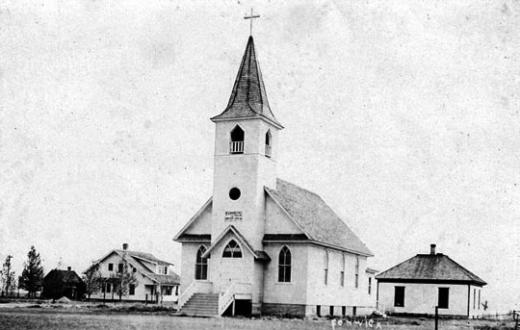
Several assassinations were attributed to Horn, but he was arrested, tried and convicted for the ambush of 13-year-old Willie Nickell in the Iron Mountain section of the Laramie Mountains north of Cheyenne in July 1901. Horn was hanged in the Laramie County jail in November 1903. His defenders have created a lively business of contesting his conviction, in publications and trial re-enactments.
The Cheyenne Club
Cheyenne was a rough town in the 1880s, but the barons of the cattle industry, many of them titled Britons or sons of wealthy families from the eastern U.S., created a club in the middle of the city where members gathered to consume fine wine and food. The Cheyenne Club, on the corner of 17th Street and Warren Avenue, incorporated on Sept. 22, 1880.
These cattle barons stayed in Cheyenne during the winter, living well and setting policies that affected the cattle industry throughout the West. Membership was restricted to the wealthy and influential. One member noted that more high-priced liquor was sold to the Cheyenne Club in its heyday than to any other club in the country.
The cattle business boomed in the early and mid 1880s, but late in the decade it was hit hard by blizzards, droughts and economic depression. Membership in the Cheyenne Club declined. The building was used in later years by the by the Industrial Club and the Cheyenne Chamber of Commerce. Eventually it fell into disrepair, and was torn down in 1936.
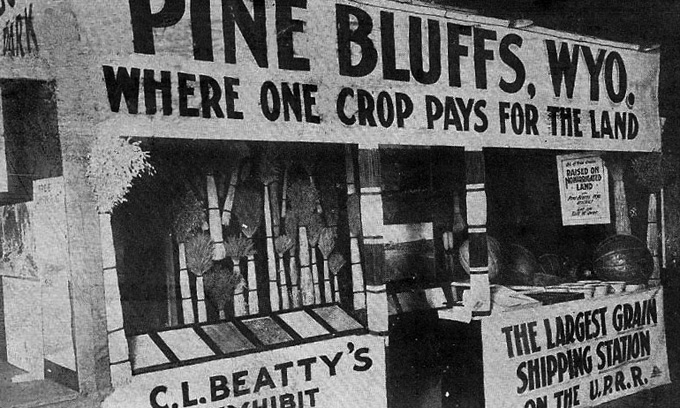
Culture and Entertainment
The public library in Laramie County had an inauspicious start in 1872, struggling to remain open and even mortgaging the books to pay bills. A pay library opened in 1886. In 1897, the Wyoming Legislature passed a new state law providing for county libraries funded by local tax revenues, and the nation’s first county library was established in Cheyenne.
Steel tycoon and philanthropist Andrew Carnegie responded with $50,000 to a plea for funds from the Laramie County Library Auxiliary Association. The Laramie County Library opened May 19, 1902, on the southeast corner of 22nd Street and Capitol Avenue, the first Carnegie library in the country. It was torn down and the library relocated in 1971, to a site at 28th and Capitol Avenue, and relocated a final time in 2007 to its present site at 22nd and Pioneer.
As Cheyenne grew and began to shake off its frontier roughness, residents desired more cosmopolitan and refined entertainment for themselves and for the visiting aristocracy, prominent politicians and wealthy businessmen who rolled through. For patrons like these, Cheyenne boasted the elegant dining and dancing at the InterOcean Hotel. In 1881, 39 citizens raised $15,000 and built a grand opera house at 17th and Hill Street, now Capitol Avenue.
After 1890, when the Denver and Rio Grande Railroad opened a new line from Denver straight to Salt Lake City, more travelers—and traveling theater companies—took that route and fewer stopped in Cheyenne. Supply of and demand for plays and operas waned. In 1902, fire partially destroyed the opera house, and in September 1961, the entire building was finally razed to make way for a new J.C. Penney store.
Cheyenne boasted four horseracing tracks before betting was outlawed. Sunday afternoon concerts were held outdoors for everyone at Fort Russell, and soldier teams competed with local baseball and football teams.
The annual 10-day Cheyenne Frontier Days celebration traces its roots to August 1897 when Cheyenne Daily Sun Leader editor Col. E.A. Slack decided that Cheyenne needed a celebration to rival Potato Day in Greeley, Colo., 55 miles to the south. Slack envisioned a show by old-time cow punchers, wild horses, old stage coaches and some Indians, “and we will have a lively time of it,” recalled friend and first Frontier Days Committee Chairman Warren Richardson. At one point, Frontier Days included a “pioneer wedding.” These were actual weddings; couples and young women competed for the chances of being the married couple and bridesmaids.
Now, Frontier Days draws hundreds of thousands of people to town for parades, rodeos and music acts the last week of July and injects more than $10 million per year into the local economy, an estimated 10 to 50 percent of the annual business for local enterprises.
Eastern Laramie County
Pine Bluffs, Wyo., about 40 miles east of Cheyenne near the Nebraska border, lies on the old Texas Trail that took cattle north to pastures in eastern Wyoming and Montana. Briefly, the town was the largest livestock shipping point on the UP line. More than 800,000 head left Texas for the northern ranges when the trails traffic peaked in 1884. The last herd came through in 1897. Rail connections had been completed to Orin Junction, near Douglas, nine years earlier.
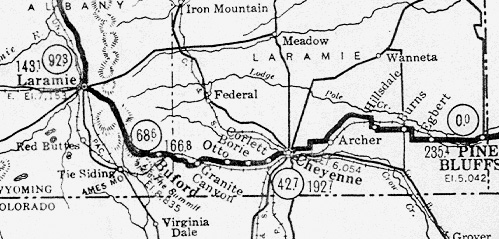
Dryland farming continued to attract newcomers to eastern Laramie County early in the 20th century. The railroads promoted dryland farming in advertising aimed at immigrant farmers, since settlement promised to increase railroad traffic. Families sometimes hired an entire railroad car to haul their farming equipment, livestock and other possessions to the whistle stop nearest the new homestead.
Burns, 26 miles east of Cheyenne, was originally established by Lutheran German immigrants on land offered by the Federal Land and Security Company, which called the area the Golden Prairie District. The town was first named Luther, and a post office established there under that name in 1907. Luther prospered with banks, businesses and the Golden Prairie Herald, all serving local communities, and passenger trains stopped there four times a day. The name of the town and the post office was changed to Burns on Feb. 10, 1910.
The agricultural communities of Laramie County suffered in the 1920s after World War I, when peacetime brought a collapse in demand and crop and livestock prices fell steeply. Things got worse after the stock market crash of 1929 brought on the Great Depression nationwide. Then came a 7-year drought. Crops failed, and farmers sold their livestock as there wasn’t enough grass for adequate pastures.
Highways
In 1913, the national Lincoln Memorial Highway Association endorsed a Wyoming route for a first transcontinental highway, rejecting Denver, St. Louis, Kansas City and other major cities in favor of the route identified by Grenville Dodge 48 years earlier. Wyoming welcomed the Lincoln Highway on Oct. 31, 1913 with a ceremony in Cheyenne, which named 16th Street “Lincolnway.” The highway then was little more than a primitive dirt road and a grand plan.
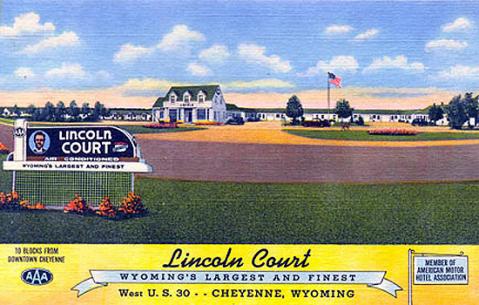
By 1919, though the Lincoln Highway was still unpaved and not yet continuous, nearly every Wyoming community along it was ready to host its intrepid motorists. During the summer of 1920, some 40,000 motorists from 32 states camped at Cheyenne during Frontier Days. In 1926, the federal government designated the Lincoln Highway as U.S. Highway 30. The newly numbered road also took a slightly different route, continuing through Pine Bluffs but bypassing Egbert, Burns and Hillsdale to the south.
Laramie County today
Today, money spent by travelers, and new businesses that rely on transportation corridors provide economic boosts. Railroads still figure significantly as well. The UP hauls freight east and west, and the Burlington Northern-Santa Fe Railroad hauls north and south through Cheyenne.
Other large employers, like Cheyenne’s school district, hospitals, and Laramie County Community College, and especially Wyoming’s state government offices, continue to stabilize the local economy and largely protect it from the boom-bust swings that dog the rest of the state.
Between 1930 and 1960, the population of Laramie County more than doubled—from 26,845 to 60,149, with most of that growth in Cheyenne. The city’s population tripled during the same decades, from 17,361 to 43,505.
The 2010 census reported the Laramie County population at 91,738, up 12.4 percent just since 2000. Cheyenne’s population was listed at 59,466, while most other towns in the county had fewer than 200 residents—that is, a steadily growing proportion of the county’s people continue to live in its city. And the county’s population gives it considerable influence in state politics. Laramie County now elects a full sixth of the Legislature: five members of the 30-member state Senate and 10 members of the 60-member state House.
Laramie County continues to benefit from its location at the crossroads of the old railroad route, paralleled first by the Lincoln Highway and now by Interstate 80, and the ancient route along the front of the mountains, now I-25.
Resources
Primary Sources
- “Big Crops a Sure Thing in the Golden Prairie of Wyo. In 1908.” advertisement, Golden Prairie Herald, June 8, 1908.
- Curran, Dennis E. “Frontier Days Brings Christmas in July.” Wyoming Business Report, August 1, 2011. Accessed Jan. 4, 2013 at http://www.wyomingbusinessreport.com/article.asp?id=59104.
- “If These Things are True…” advertisement by the Federal Land and Securities Co., Luther, Laramie County, Wyo. Golden Prairie Herald, 1:8, June 15, 1908, p. 4. Accessed Jan. 4, 2013 via the Wyoming Newspaper Project, http://wyonewspapers.org/.
- Rhoten, Josh. “CFD numbers up.” Wyoming Tribune Eagle, Aug. 2, 2011. Accessed Jan. 3, 2013 at http://www.wyomingnews.com/articles/2011/08/02/news/20local_08-02-11.txt.
- “See Who’s Here! A Partial List of the Settlers and Investors on the Golden Prairie.” Golden Prairie Herald, 1:8, June 15, 1908, p. 3. Accessed Jan. 4, 2013 via the Wyoming Newspaper Project, http://wyonewspapers.org/.
Secondary Sources
- Adams, Col. Gerald M. Adams, USAF (Ret.). The Post near Cheyenne, a History of Fort D.A. Russell 1867-1930. Cheyenne: High Flyer Publications, 1997.
- Bartlett, I.S., ed. History of Wyoming, Volume II. Chicago: The S.J. Clarke Publishing Co., 1918.
- Bastian, Jean and Ruth Mittan. A History of Luther/Burns Wyoming. Wolfe City, Texas: Henington Publishing Co., 1988.
- Centennial Historic Committee, J.O. Reed, Chairman. The Magic City of the Plains. Cheyenne: Centennial History Committee, 1967.
- Coutant, C. G. Previously unpublished History of Wyoming. Annals of Wyoming, vols. 12-14.
- Erwin, Marie, ed. Wyoming Blue Book, vol. I. Cheyenne: Wyoming Archives and Historical Department, 1974.
- Field, Sharon Lass, ed. History of Cheyenne, Wyoming, volume II. Dallas, Tex.: Curtis Media Corp., 1989.
- Frink, Maurice. Cow Country Cavalcade: Eighty Years of the Wyoming Stock Growers Association. Denver: The Old West Publishing Co. 1954.
- Hanesworth, Robert D. “Early History of Cheyenne ‘Frontier Days’ Show.” Annals of Wyoming, 12:3 pp. 199-211.
- Jackson, Turrentine. “Administration of Thomas Moonlight.” Annals of Wyoming, 18:2, p. 157.
- Kendall, Jane. “History of Fort Francis E. Warren.” Annals of Wyoming, 18:1, pp.3-66.
- Larson, T.A. History of Wyoming. Lincoln: University of Nebraska Press 1965.
- Love, Louise. “The Dedication of Texas Trail Monuments.” Annals of Wyoming, 21:1:93.
- Page, Vicki and William L. Hewitt. “The Changing Face of Cowboy State Agriculture.” Annals of Wyoming, 60:1, pp. 25-26.
- Patterson, Richard. Wyoming’s Outlaw Days. Boulder, Colo.: Johnson Publishing Co., 1982.
- Shields, Alice M. “Edwin J. Smalley, One of Cheyenne’s First Native Sons.” Annals of Wyoming, 13:1, pp. 58-72.
- Wyoming. A Guide to Its History, Highways, and People. Compiled by workers of the Writers’ Program of the Work Projects Administration in the State of Wyoming, sponsored by Dr. Lester C. Hunt, Secretary of State. Oxford University Press, New York 1941.
- White, Kris A. Evolution of Roads Across Southern Wyoming. http://uwacadweb.uwyo.edu/robertshistory/evolution_of_roads_across_southe.htm
- Wikipedia. “Battle of Opequon.” Accessed Dec. 7, 2012, at http://en.wikipedia.org/wiki/Battle_of_Opequon.
Illustrations
- The photo of the state capitol in Cheyenne is by J. Stephen Conn, from Panoramio. Used with thanks.
- The bird’s-eye view of Cheyenne in 1870 is from the Wyoming State Archives by way of Wyoming Places. Used with thanks.
- The photo of the Rollins House hotel in Cheyenne in 1869 is by William Henry Jackson, from the US Geological Survey’s photo library. Wyoming’s Territorial Legislature sometimes met at the Rollins House in the years before the capitol was built.
- The undated photo of the Lutheran church in Burns, the map of the Lincoln Highway across Laramie County and the postcard of the Lincoln Court in Cheyenne are from Wyoming Tales and Trails. Used with thanks. The Lincoln Court later became the Hitching Post Inn.
- The 1911 photo of the town of Pine Bluffs’ exhibit at the Omaha Land Show is also from Wyoming Tales and Trails. By then the town had shifted its focus from shipping cattle to shipping dry farmers’ grain. Its claim to be the Union Pacific’s largest grain-shipping point was probably exaggerated, however. Used with thanks.
